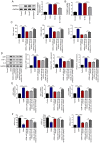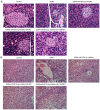miR‑875‑5p regulates IR and inflammation via targeting TXNRD1 in gestational diabetes rats
- PMID: 33649852
- PMCID: PMC7974266
- DOI: 10.3892/mmr.2021.11942
miR‑875‑5p regulates IR and inflammation via targeting TXNRD1 in gestational diabetes rats
Abstract
Gestational diabetes mellitus (GDM) is a serious life‑threatening disease that affects the mother and fetus. However, the pathogenesis of GDM is still unclear. microRNAs (miRs) play vital roles in the regulation of various cell functions. The present study aimed to investigate the effects of miR‑875‑5p and thioredoxin reductase 1 cytoplasmic (TXNRD1) in GDM rats and analyze the associated underlying mechanism. A GDM rat model was induced using an intraperitoneal injection of streptozotocin. miR‑875‑5p knockdown plasmids or TXNRD1 knockdown plasmids were injected into the rats via the caudal vein. miR‑875‑5p and TXNRD1 expression in the serum were detected using reverse transcription‑quantitative PCR (RT‑qPCR) or western blot (WB) analyses. The fasting blood‑glucose (FBG), fasting serum insulin, triglyceride and high density lipoprotein levels were detected by specific commercial kits. The inflammatory response and the induction of oxidative stress were analyzed by assessing the expression of associated markers via WB, RT‑qPCR or commercial kits. The pancreatic and placental injuries were detected by hematoxylin and eosin staining. The results indicated that miR‑875‑5p expression levels were downregulated, whereas TXNRD1 levels were upregulated in GDM rats compared with normal pregnancy rats. miR‑875‑5p significantly regulated TXNRD1 expression in GDM rats. miR‑875‑5p silencing notably reduced FBG and insulin resistance, which was accompanied by reduced expression levels of blood lipid and pro‑inflammatory markers as well as reduced oxidative stress. However, the effects of miR‑875‑5p could be reversed by TXNRD1 silencing. Therefore, the present study indicated that miR‑875‑5p regulated IR and inflammation by targeting TXNRD1 in GDM rats. miR‑875‑5p and TXNRD1 may be considered as potential targets for treating GDM.
Keywords: gestational diabetes mellitus; microRNA‑875‑5p; thioredoxin reductase 1 cytoplasmic; inflammation.
Conflict of interest statement
The authors declare that they have no competing interests.
Figures






Similar articles
-
Proinflammation in maternal and fetal livers and circulating miR-122 dysregulation in a GDM rat model induced by intrauterine programming.Mol Cell Endocrinol. 2020 Jun 15;510:110824. doi: 10.1016/j.mce.2020.110824. Epub 2020 Apr 18. Mol Cell Endocrinol. 2020. PMID: 32315718
-
Effects of miR-152-Mediated Targeting of SOCS3 on Hepatic Insulin Resistance in Gestational Diabetes Mellitus Mice.Am J Med Sci. 2021 Mar;361(3):365-374. doi: 10.1016/j.amjms.2020.06.032. Epub 2020 Jul 9. Am J Med Sci. 2021. PMID: 32718473
-
MicroRNA-351 eases insulin resistance and liver gluconeogenesis via the PI3K/AKT pathway by inhibiting FLOT2 in mice of gestational diabetes mellitus.J Cell Mol Med. 2019 Sep;23(9):5895-5906. doi: 10.1111/jcmm.14079. Epub 2019 Jul 9. J Cell Mol Med. 2019. PMID: 31287224 Free PMC article.
-
Unveiling the role of microRNAs in metabolic dysregulation of Gestational Diabetes Mellitus.Reprod Biol. 2024 Sep;24(3):100924. doi: 10.1016/j.repbio.2024.100924. Epub 2024 Jul 15. Reprod Biol. 2024. PMID: 39013209 Review.
-
Biomarkers of Gestational Diabetes Mellitus: Mechanisms, Advances, and Clinical Utility.J Assoc Physicians India. 2025 Feb;73(2):56-67. doi: 10.59556/japi.73.0849. J Assoc Physicians India. 2025. PMID: 39928001 Review.
Cited by
-
MicroRNA‑143‑3p levels are reduced in the peripheral blood of patients with gestational diabetes mellitus and influences pancreatic β‑cell function and viability.Exp Ther Med. 2022 Dec 30;25(2):81. doi: 10.3892/etm.2022.11780. eCollection 2023 Feb. Exp Ther Med. 2022. PMID: 36684655 Free PMC article.
-
Baicalein inhibits NLRP3 inflammasome activation and mitigates placental inflammation and oxidative stress in gestational diabetes mellitus.Open Life Sci. 2024 Dec 31;19(1):20220966. doi: 10.1515/biol-2022-0966. eCollection 2024. Open Life Sci. 2024. PMID: 39759105 Free PMC article.
-
An in vitro approach to understand contribution of kidney cells to human urinary extracellular vesicles.J Extracell Vesicles. 2023 Feb;12(2):e12304. doi: 10.1002/jev2.12304. J Extracell Vesicles. 2023. PMID: 36785873 Free PMC article.
-
The role of ncRNA regulatory mechanisms in diseases-case on gestational diabetes.Brief Bioinform. 2023 Nov 22;25(1):bbad489. doi: 10.1093/bib/bbad489. Brief Bioinform. 2023. PMID: 38189542 Free PMC article. Review.
-
Bioinformatic identification of signature miRNAs associated with fetoplacental vascular dysfunction in gestational diabetes mellitus.Biochem Biophys Rep. 2024 Dec 16;41:101888. doi: 10.1016/j.bbrep.2024.101888. eCollection 2025 Mar. Biochem Biophys Rep. 2024. PMID: 39802395 Free PMC article.
References
-
- Metzger BE, Coustan DR, The Organizing Committee Summary and recommendations of the Fourth International Workshop-Conference on Gestational Diabetes Mellitus. Diabetes Care. 1998;21(Suppl 2):B161–B167. - PubMed
-
- Hajifaraji M, Jahanjou F, Abbasalizadeh F, Aghamohammadzadeh N, Abbasi MM, Dolatkhah N. Effect of probiotic supplements in women with gestational diabetes mellitus on inflammation and oxidative stress biomarkers: A randomized clinical trial. Asia Pac J Clin Nutr. 2018;27:581–591. - PubMed
MeSH terms
Substances
LinkOut - more resources
Full Text Sources
Other Literature Sources

